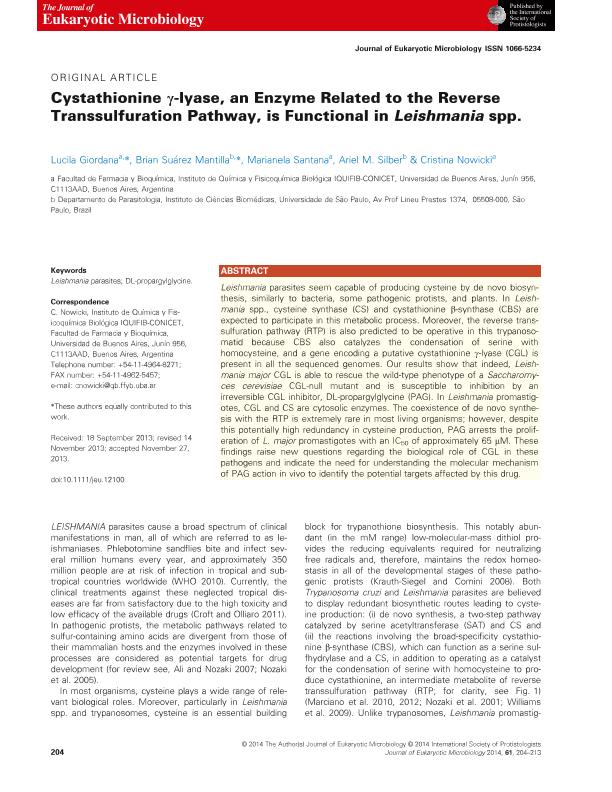Artículo
Cystathionine γ-lyase, an Enzyme Related to the Reverse Transsulfuration Pathway, is Functional in Leishmania spp.
Giordana, Lucila ; Suárez Mantilla, Brian; Santana, Marianela
; Suárez Mantilla, Brian; Santana, Marianela ; Silber, Ariel Mariano; Nowicki, Cristina
; Silber, Ariel Mariano; Nowicki, Cristina
 ; Suárez Mantilla, Brian; Santana, Marianela
; Suárez Mantilla, Brian; Santana, Marianela ; Silber, Ariel Mariano; Nowicki, Cristina
; Silber, Ariel Mariano; Nowicki, Cristina
Fecha de publicación:
03/2014
Editorial:
Wiley Blackwell Publishing, Inc
Revista:
Journal of Eukaryotic Microbiology
ISSN:
1066-5234
Idioma:
Inglés
Tipo de recurso:
Artículo publicado
Clasificación temática:
Resumen
Leishmania parasites seem capable of producing cysteine by de novo biosynthesis, similarly to bacteria, some pathogenic protists, and plants. In Leishmania spp., cysteine synthase (CS) and cystathionine β-synthase (CBS) are expected to participate in this metabolic process. Moreover, the reverse transsulfuration pathway (RTP) is also predicted to be operative in this trypanosomatid because CBS also catalyzes the condensation of serine with homocysteine, and a gene encoding a putative cystathionine γ-lyase (CGL) is present in all the sequenced genomes. Our results show that indeed, Leishmania major CGL is able to rescue the wild-type phenotype of a Saccharomyces cerevisiae CGL-null mutant and is susceptible to inhibition by an irreversible CGL inhibitor, DL-propargylglycine (PAG). In Leishmania promastigotes, CGL and CS are cytosolic enzymes. The coexistence of de novo synthesis with the RTP is extremely rare in most living organisms; however, despite this potentially high redundancy in cysteine production, PAG arrests the proliferation of L. major promastigotes with an IC50 of approximately 65 μM. These findings raise new questions regarding the biological role of CGL in these pathogens and indicate the need for understanding the molecular mechanism of PAG action in vivo to identify the potential targets affected by this drug.
Palabras clave:
Leishmania Parasites
,
Dl-Propargylglycine
Archivos asociados
Licencia
Identificadores
Colecciones
Articulos(INIBIOLP)
Articulos de INST.DE INVEST.BIOQUIMICAS DE LA PLATA
Articulos de INST.DE INVEST.BIOQUIMICAS DE LA PLATA
Citación
Nowicki, Cristina; Silber, Ariel Mariano; Santana, Marianela; Suárez Mantilla, Brian; Giordana, Lucila; Cystathionine γ-lyase, an Enzyme Related to the Reverse Transsulfuration Pathway, is Functional in Leishmania spp.; Wiley Blackwell Publishing, Inc; Journal of Eukaryotic Microbiology; 61; 2; 3-2014; 204-213
Compartir
Altmétricas



